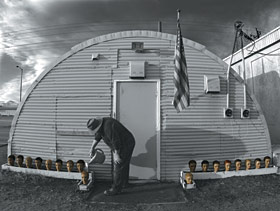Books may be purchased through the Anchorage Museum Shop or Princeton Architectural Press.
Alaska was no different from the rest of the country in terms of a need for permanent housing, but it also seemed to have an added burden. Not only did it have its own soldiers returning home from war and starting families, it also had the immigration of men previously stationed in the territory who wanted to make it their new home. These men found Alaska so alluring that they returned home just long enough to gather their families and bring them north.
Before long the headlines once reserved for war were replaced with accounts of a housing shortage that grew to epidemic proportion. On January 20, 1945, an article in the Fairbanks Daily News Miner indicated at least two hundred Fairbanks's families were living in shacks for lack of better housing. That same day, a survey released by the Anchorage Chamber of Commerce declared that thirteen families had searched for a place to rent, without success, for five months or more. By September 3, the following year, 1,482 Anchorage families would be estimated homeless. The severity of this issue at its peak is probably best summarized by Governor Ernest Greuning in his Annual Report of the Governor of Alaska:

Fresh Crop, 2004
Digitally-manipulated photograph by Chris Arend
Between 1942 and 1945 the people of Anchorage seem to live in harmony with their Quonset neighbors. It was as though they accepted these structures for their part in the war effort. One Quonset camp was erected in the railway yard at Ship Creek, the very birthplace of Anchorage's original tent city. Huts were laid out nearly end-to-end in long rows. Called the "Snake Ranch," this camp was the home of the 714th Railway Operating Battalion, a military contingent deployed to assist the Alaska Railroad in efficient transportation of military supplies. Having served the territory for twenty-five months, the battalion was relieved of duty on May 7, 1945. They were shipped out three days later. Left behind was a village of Quonset huts that stood silent amidst the desperate cries of a housing shortage.
youtube watch time